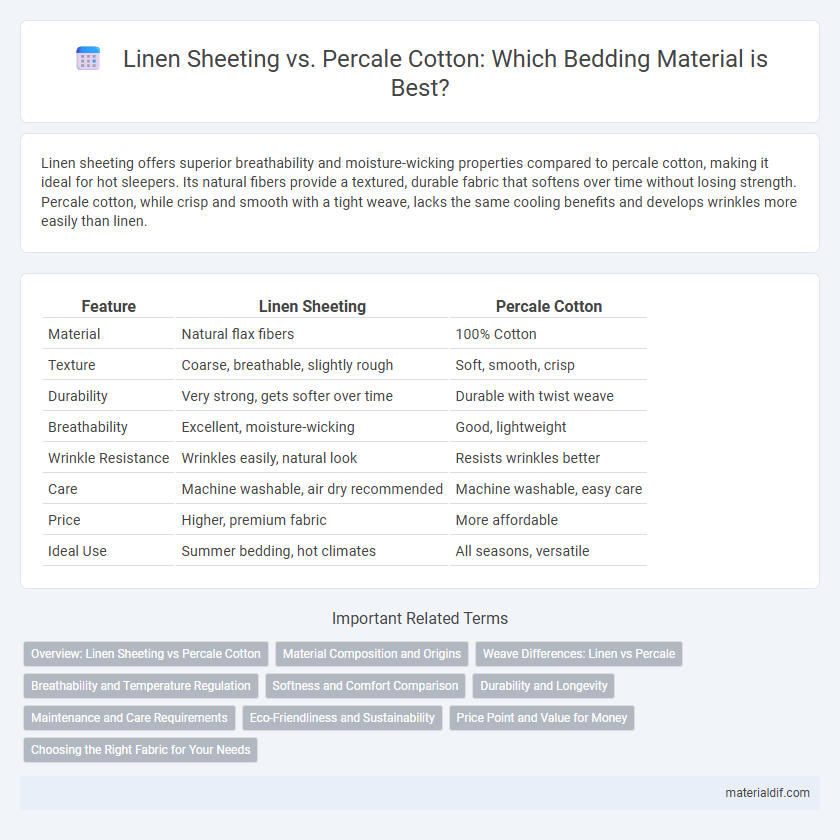Linen sheeting offers superior breathability and moisture-wicking properties compared to percale cotton, making it ideal for hot sleepers. Its natural fibers provide a textured, durable fabric that softens over time without losing strength. Percale cotton, while crisp and smooth with a tight weave, lacks the same cooling benefits and develops wrinkles more easily than linen.
Table of Comparison
| Feature | Linen Sheeting | Percale Cotton |
|---|---|---|
| Material | Natural flax fibers | 100% Cotton |
| Texture | Coarse, breathable, slightly rough | Soft, smooth, crisp |
| Durability | Very strong, gets softer over time | Durable with twist weave |
| Breathability | Excellent, moisture-wicking | Good, lightweight |
| Wrinkle Resistance | Wrinkles easily, natural look | Resists wrinkles better |
| Care | Machine washable, air dry recommended | Machine washable, easy care |
| Price | Higher, premium fabric | More affordable |
| Ideal Use | Summer bedding, hot climates | All seasons, versatile |
Overview: Linen Sheeting vs Percale Cotton
Linen sheeting offers superior breathability and moisture-wicking properties compared to percale cotton, making it ideal for warm climates and hot sleepers. Percale cotton is known for its crisp, smooth texture and durability, providing a lightweight and cool feel with a matte finish. Both fabrics are breathable and durable, but linen's natural fibers deliver a more textured, organic aesthetic while percale cotton is favored for its consistent softness and easy maintenance.
Material Composition and Origins
Linen sheeting is crafted from flax fibers, originating from the flax plant primarily grown in Europe, which imparts a natural, breathable texture ideal for warm climates. Percale cotton sheeting is made from tightly woven cotton fibers, typically sourced from the United States, India, or Egypt, offering a smooth, crisp feel with enhanced durability. The distinct fiber characteristics of linen and percale cotton influence moisture-wicking properties, breathability, and overall comfort in bedding materials.
Weave Differences: Linen vs Percale
Linen sheeting features a plain weave made from flax fibers, resulting in a textured, breathable fabric with natural slubs that enhance airflow and durability. Percale cotton is woven with a tight, simple plain weave using finely spun cotton threads, producing a smooth, crisp surface that feels cool and lightweight. The key weave difference lies in linen's irregular fiber texture creating a looser, more airy structure, compared to percale's consistent, dense weave offering a crisp, polished finish.
Breathability and Temperature Regulation
Linen sheeting offers superior breathability, allowing moisture and heat to escape quickly for a cooler sleep environment compared to percale cotton. The natural fibers in linen provide excellent temperature regulation by wicking away sweat and enhancing airflow. Percale cotton sheets are lightweight and breathable but tend to retain more heat, making linen an ideal choice for hot sleepers or warm climates.
Softness and Comfort Comparison
Linen sheeting offers a breathable, naturally textured feel that softens with each wash, providing unmatched comfort in warm climates. Percale cotton features a crisp, smooth weave that feels cool and lightweight but may lack the inherent softness of lived-in linen. While percale excels in a smooth, matte finish, linen's unique fiber structure delivers superior moisture-wicking and temperature regulation for enhanced sleep comfort.
Durability and Longevity
Linen sheeting is known for its exceptional durability due to its long, strong fibers that become softer and more resilient with each wash, often outlasting percale cotton by several years. Percale cotton, while also durable, typically shows wear sooner as its shorter fibers are prone to pilling and thinning over time. Choosing linen ensures a longer lifespan and sustained quality for bedding that endures frequent use.
Maintenance and Care Requirements
Linen sheeting demands gentle washing in cold water with mild detergent to maintain its natural fibers and prevent shrinking, often benefiting from air drying or low heat settings. Percale cotton is easier to care for, typically machine washable in warm water and durable enough to withstand frequent laundering without significant wear. Both fabrics require ironing for a crisp finish, but linen wrinkles more readily and may need more frequent touch-ups compared to the smoother, tightly woven percale cotton.
Eco-Friendliness and Sustainability
Linen sheeting is more eco-friendly than percale cotton due to its lower water usage, biodegradable fibers, and natural pest resistance, which reduces the need for harmful pesticides. Flax plants, used to produce linen, require fewer resources and generate less environmental impact compared to cotton cultivation, making linen a sustainable choice for bedding. The durability and long lifespan of linen sheets also contribute to less frequent replacement, minimizing waste and promoting sustainability.
Price Point and Value for Money
Linen sheeting typically commands a higher price point than percale cotton due to its natural durability and breathability, making it a longer-lasting investment. While percale cotton offers a crisp, smooth texture at a more affordable cost, linen's moisture-wicking and temperature-regulating properties provide superior comfort, enhancing its overall value for money. Consumers seeking durability and luxury often find linen's premium price justified by its longevity and performance benefits compared to percale cotton.
Choosing the Right Fabric for Your Needs
Linen sheeting offers exceptional breathability and durability, making it ideal for hot climates and those seeking natural moisture-wicking properties. Percale cotton features a crisp, smooth texture and is favored for its lightweight feel and easy maintenance, perfect for cooler temperatures and allergy-prone sleepers. Selecting between linen and percale cotton depends on factors like desired fabric breathability, temperature regulation, and personal comfort preferences.
Linen Sheeting vs Percale Cotton Infographic

 materialdif.com
materialdif.com